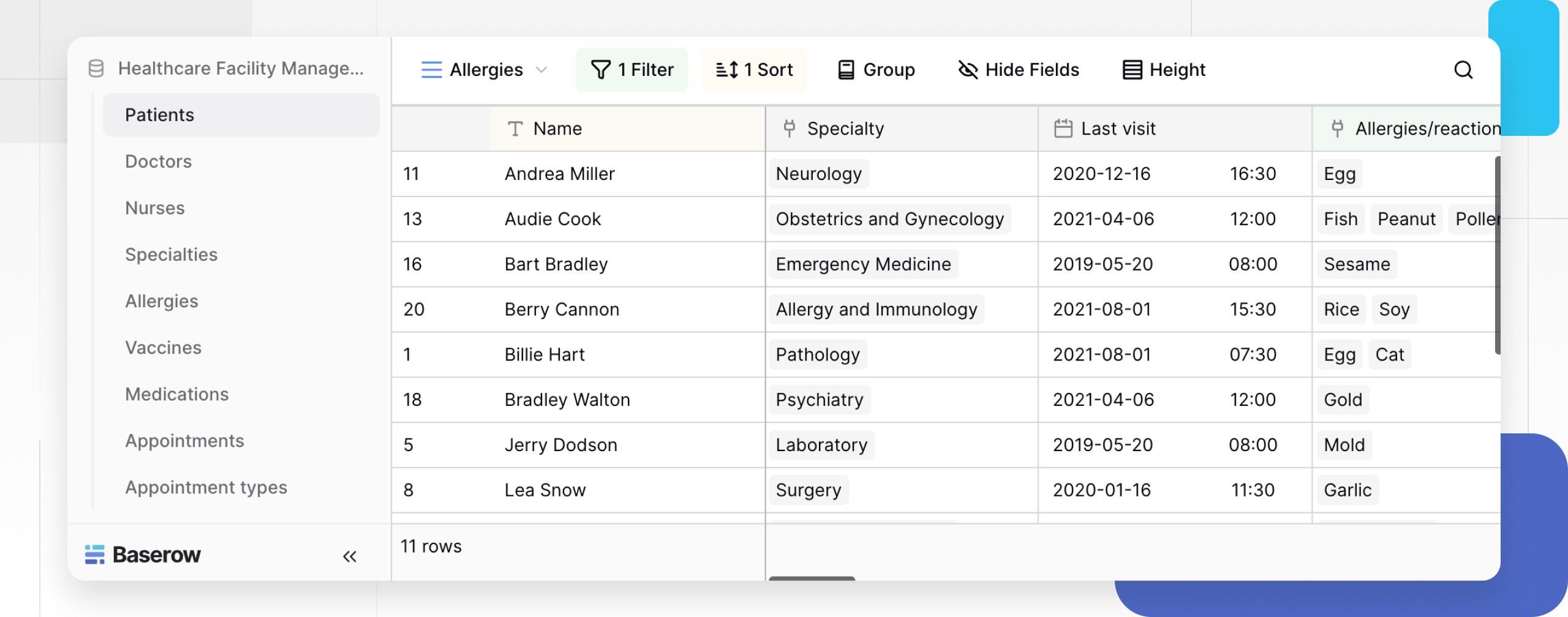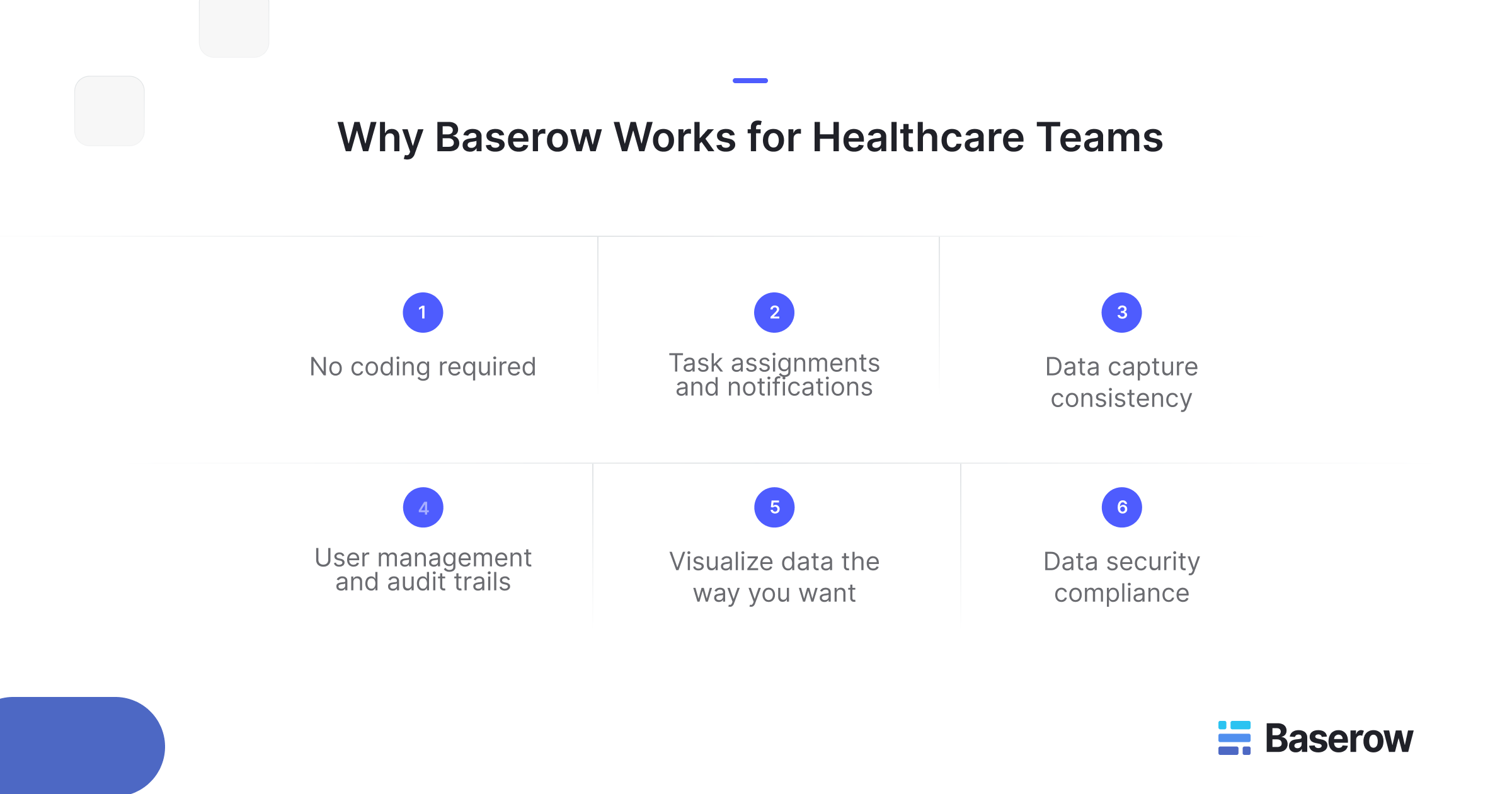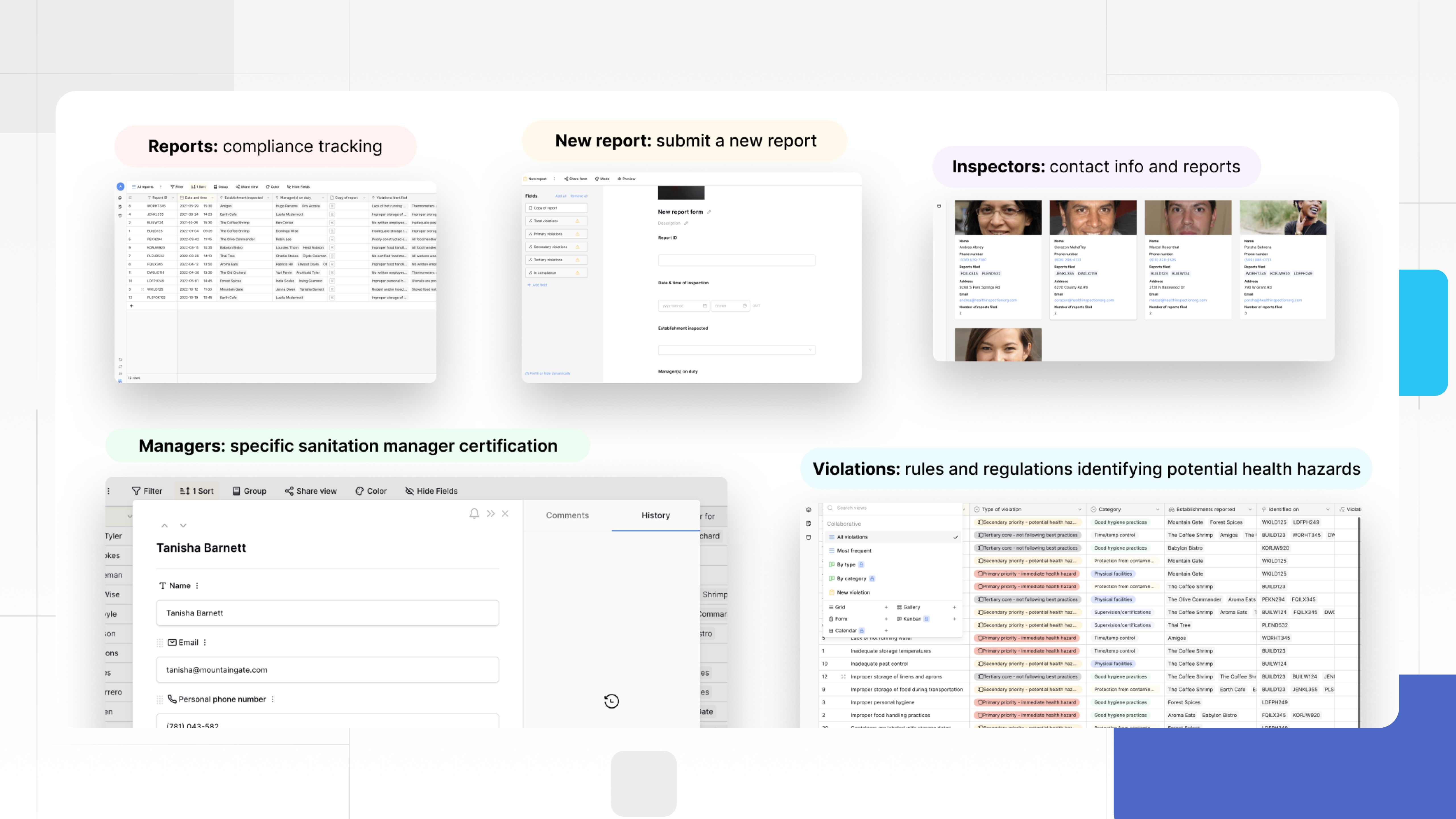
In today’s fast-paced clinical environments, managing patient information efficiently and securely has become non-negotiable. As healthcare continues its digital transformation, EHR Systems (Electronic Health Record Systems) have emerged as indispensable tools for modern medical practices. They don’t just store patient information — they drive better care coordination, reduce administrative burdens, and help clinics make informed, data-driven decisions.
With the right EHR system, clinics can significantly boost their operational efficiency, enable cost savings, and enhance the quality of care they deliver. But with so many platforms available in the market, choosing the right EHR system for your clinic in 2025 can be a challenge.
This guide explores the top EHR systems for clinics, their features, benefits, and how to evaluate them. We also touch upon how tools like Baserow — an open-source no-code database platform — can support clinics in organizing and managing clinical and patient data effectively alongside EHR systems.
What Is an EHR System?
An Electronic Health Record (EHR) system is a digital platform that collects, stores, and manages patients’ health information in real time. Unlike electronic medical records (EMRs), which are generally limited to one provider’s office, EHRs are designed to share information across multiple healthcare settings — from general practitioners to specialists and hospitals.

5 Common Functions of EHR Systems:
- Comprehensive patient data storage: EHRs store everything from demographics and allergies to test results and diagnoses.
- Access patient records across different clinics, ensuring continuity of care.
- Enable clinical decision support through alerts, reminders, and diagnosis suggestions.
- Support for patient portals that improve engagement by giving patients access to their health data.
- Integrated revenue cycle management for smoother billing and claims processing.
Ultimately, a well-integrated electronic health records system boosts accuracy, cuts down on manual paperwork, and fosters a more coordinated approach to healthcare delivery.
Why Clinics Need an EHR System in 2025
The landscape of outpatient care is rapidly evolving. With increasing patient volumes, growing regulatory complexity, and a focus on value-based care, clinics need more than just patient charts—they need powerful systems to connect the dots.
Benefits of Modern EHR Systems:
- Cost savings through reduced redundancies and digitized workflows.
- Improved data security and HIPAA compliance.
- Cloud based EHR solutions that allow remote access to patient data.
- Better decision-making through evidence-based analytics.
- Enhanced medical history tracking for long-term patient outcomes.
These systems are designed not only for storage but to support real-time collaboration, analytics, and decision-making — core components of modern medicine.
Supporting Systems Like Baserow
While traditional EHRs focus on patient care records, platforms like Baserow for Healthcare provide customizable, no-code databases that clinics can use to support their EHR strategies. Clinics can create custom dashboards to track operational data, research findings, or referral patterns — without needing to touch a single line of code.
With drag-and-drop ease, Baserow complements your EHR infrastructure by helping you organize non-clinical workflows, internal processes, or trial runs for data migration before you go live with a new EHR vendor.
1. Baserow: Supporting Platform for EHR Workflows
While not an EHR system in the traditional sense, Baserow is a powerful open-source, no-code database platform that helps clinics streamline and manage data workflows that support their EHR system.
Key benefits:
- Build custom databases to prototype electronic medical records (EMRs) and clinical workflows.
- Organize patient data, referral logs, provider directories, and compliance tracking.
- Integrate with EHR systems using APIs to extend functionality.
- Improve visibility across operations with flexible dashboards and tables.
Baserow enables healthcare professionals to handle workflows that most EHRs don’t natively support — all without writing a single line of code. It’s the perfect companion for clinics looking to take control of their operational data strategy.
👉 Explore Baserow for healthcare

Other EHR Systems for Clinics in 2025
Choosing an EHR system involves evaluating not just features but how they align with your clinic’s unique needs, scale, and specialties. Sharing other contenders leading the way in 2025:
2. Epic Systems
A dominant name in large hospitals, Epic has increasingly tailored solutions for clinics and smaller providers. Their EHR offers:
- Seamless interoperability across networks.
- Comprehensive clinical decision support.
- Telehealth, e-prescribing, and patient portals in one platform.
Epic is best suited for multi-specialty clinics looking for high customization and deep analytics.
3. Cerner (Now Oracle Health)
Cerner is known for its scalability and intuitive UI. Their focus on population health makes them ideal for clinics with public health programs.
- Strong clinical data analytics tools.
- Population-level insights.
- Streamlined electronic health record (EHR) workflows for physicians and nurses.
Cerner supports robust integrations, enabling clinics to link with labs, imaging centers, and more.
4. athenahealth
A standout cloud based EHR solution, athenahealth is known for its ease of use and automation of administrative processes. It provides:
- Powerful revenue cycle management tools.
- Automated claim submissions.
- AI-powered workflows that save time.
athenahealth is a great option for clinics looking to scale and reduce overhead without sacrificing care quality.
5. Kareo
Kareo is specifically designed for small practices, offering a simplified experience that includes billing, scheduling, and marketing support. It’s a fully cloud-based EHR platform tailored to independent clinics that need affordability without sacrificing core functionality.
Key features:
- Intuitive interface and fast implementation.
- Seamless integration with billing software.
- Patient engagement tools like SMS reminders and telehealth.
Kareo is especially beneficial for practices looking to streamline operations without hiring in-house IT staff — making it a cost-effective option that still delivers value.
6. NextGen Healthcare
NextGen is ideal for specialty clinics that require customizable features. Known for its flexibility, it supports a wide range of specialty templates and offers a deeply configurable dashboard.
Key strengths:
- Specialty-specific templates for faster charting.
- Advanced tools for clinical decision support.
- Integrated analytics and mobile accessibility.
Its patient-focused design allows healthcare professionals to spend less time on screens and more time delivering care — aligning perfectly with the goals of modern, patient-centered clinics.
7. Practice Fusion
Practice Fusion is a cloud based EHR that’s perfect for small to mid-sized medical practices. Acquired by Allscripts, it has maintained its simplicity and user-friendliness while evolving into a more powerful EHR platform.
Why it stands out:
- No setup costs for core EHR features.
- Built-in charting tools and templates.
- Secure e-prescribing, immunization records, and electronic health records system management.
Because it’s hosted in the cloud, Practice Fusion doesn’t require complex installations or expensive servers — making it especially useful for startups or growing clinics looking for budget-friendly EHR software.
How to Choose the Right EHR Vendor
Selecting the right EHR vendor is more than just comparing features. It involves understanding the unique needs of your clinic — both now and in the future. Consider the following factors:
1. Clinic Size and Specialty
- Is your clinic a small general practice or a growing multi-specialty provider?
- Do you require niche templates or customizable workflows?
2. Budget and Cost Structure
- Are there hidden fees for add-ons, support, or training?
- Does the vendor offer cost savings over time?
3. Ease of Use
- Is the UI intuitive?
- Can non-technical staff quickly adapt to the system?
4. Interoperability and Data Sharing
- Will the system integrate with other platforms (labs, pharmacies, imaging tools)?
- Can it access patient records across providers?
5. Cloud Accessibility
- Can your team access the EHR remotely?
- Is the system a cloud based EHR solution or does it rely on on-premise servers?
6. Security and Compliance
- Does it offer secure encryption and HIPAA compliance?
- Are there audit logs and backup protocols?
Before signing a long-term agreement, clinics should trial the system and request demos. Some EHR vendors also offer sandbox environments where staff can test workflows using dummy clinical data.
Baserow’s Role in EHR Evaluation
Before choosing an EHR vendor, many clinics use tools like Baserow to simulate their data management processes. Baserow helps medical teams:
- Create mock databases of patient data or medical history.
- Structure and visualize internal workflows.
- Map out data relationships (e.g., provider-to-patient links, diagnosis records).
This allows clinics to test interoperability and structure requirements before migrating to a permanent EHR solution — minimizing disruptions and improving implementation success rates.
Common Challenges in EHR Implementation (And How to Solve Them)
Despite the clear benefits, implementing an EHR can be complex. Here are some of the most frequent challenges — and how to solve them:
1. Data Migration Issues
Migrating from paper charts or legacy EMRs to a new EHR can risk data loss or errors. A structured migration plan is essential.
Solution: Use platforms like Baserow to pre-organize and clean data before importing into the new system.
2. Staff Resistance or Training Gaps
New systems can lead to staff pushback, especially if training is inadequate.
Solution: Choose an EHR system designed with user-friendly navigation, and schedule phased training.
3. Workflow Disruption
Initial adoption often slows productivity as teams adjust.
Solution: Run pilot programs using test data to fine-tune workflows and roles — something easily done with Baserow’s flexible database templates.
4. Interoperability Limitations
Some EHRs don’t play well with others, limiting referrals or coordination.
Solution: Select vendors that support HL7/FHIR standards, and use a modular data platform like Baserow to manage supplementary data.
The Future of EHR: What’s Next?
As clinics move deeper into 2025 and beyond, EHR systems are evolving in exciting ways. The next generation of EHRs goes far beyond static record-keeping — they are becoming intelligent, predictive platforms that help drive decisions, automate workflows, and engage patients in meaningful ways.
Key Trends Shaping the Future of EHR Systems:
🔹 AI-Powered Clinical Decision Support
EHRs are increasingly integrating clinical decision support tools that leverage artificial intelligence to help clinicians identify risks, flag anomalies in lab reports, and recommend evidence-based treatments.
For instance, predictive algorithms can analyze a patient’s medical history and flag early signs of chronic illness or potential medication conflicts — helping prevent adverse outcomes and improving the quality of care.
🔹 Patient Portals 2.0
Modern patient portals are evolving into full-scale engagement platforms. These portals no longer just display lab results — they allow for:
- Secure messaging between patients and providers.
- Appointment scheduling.
- Telehealth visits.
- Patient-entered health data integration from wearables and apps.
This evolution deepens patient involvement in their own care and supports better long-term health outcomes.
🔹 Unified, API-First Systems
Many EHR vendors are now adopting API-first architectures to enable seamless interoperability between apps, labs, imaging systems, and hospital networks. This open framework supports faster innovation and allows clinics to build custom tools on top of their electronic health record EHR infrastructure.
This is where platforms like Baserow shine — providing a flexible backend where clinics can store auxiliary data and prototype healthcare apps before scaling.
🔹 Cloud-Based and Mobile-Ready
Legacy systems often relied on clunky desktop-based setups, but the future is mobile. With cloud based EHR solutions, clinicians can now:
- Chart patient visits on tablets.
- Review diagnostic results remotely.
- Access clinical schedules and access patient records from anywhere.
This flexibility is crucial in today’s distributed care environments, especially for mobile clinics, home health services, or providers managing multiple locations.
🔹 Integrated Revenue Cycle Management
Billing isn’t an afterthought anymore. Modern EHRs integrate revenue cycle management tools directly into their platforms to streamline reimbursements and reduce denials. From coding support to claims tracking, the EHR becomes an all-in-one financial and clinical command center.
Final Thoughts: Choosing and Supporting the Right EHR System
The best EHR system for your clinic is the one that aligns with your medical, operational, and patient-care goals. Whether you’re a small independent provider or part of a larger group practice, the right solution will:
- Improve efficiency and reduce manual entry.
- Support better patient outcomes with data-driven insights.
- Enhance communication between care teams and patients.
- Deliver cost savings through smart billing.
- Work on premade templates to improve efficiency

But choosing a solution is just the beginning. Implementation, customization, and staff adoption are equally important — and that’s where complementary platforms like Baserow for Healthcare can help.
How Baserow Supports Smarter EHR Adoption
Baserow isn’t an EHR system — but it supports EHR processes in ways that fill the gaps many clinics experience.
Use Cases for Clinics:
- Design EHR-compatible databases to plan data models and test integrations.
- Track non-clinical data like vendor lists, training logs, or compliance deadlines.
- Build internal dashboards for monitoring KPIs like patient retention or provider performance.
- Create custom tools that bridge your EHR and other platforms using Baserow’s open-source framework and API.
Whether you’re preparing for EHR adoption or looking to optimize existing workflows, Baserow helps you stay organized, agile, and fully in control of your data.
You can even use Baserow to:
- Plan out custom patient flows.
- Manage referrals and outreach campaigns.
- Prototype clinical trial databases or registries.
👉 Explore Baserow for healthcare workflows
Ready to Modernize Your Clinic’s Data Strategy?
EHR systems are essential — but so is how you support and supplement them.
As clinics grow, manage more patients, and adopt more technology, they need tools that are just as flexible as they are powerful. Baserow helps you build, adapt, and extend your data processes — whether you’re preparing for an EHR migration, supplementing your existing system, or managing clinical data beyond your EHR’s scope.
Start building smarter, more efficient healthcare operations today.
👉 Sign up for Baserow – it’s free to get started
In 2025, the best EHR systems aren’t just digital filing cabinets. They’re intelligent, interoperable platforms designed to support holistic, patient-centered care. Choosing the right EHR vendor, understanding key functions like clinical decision support and revenue cycle management, and supplementing your system with platforms like Baserow can dramatically elevate your clinic’s capabilities.
Your data shouldn’t be a bottleneck — it should be your competitive advantage.

Baserow 2.0 introduces the automations builder, upgraded AI fields, the Kuma AI assistant, enhanced workflow logic with formulas and variables, improved workspace search, and stronger security with 2FA.

Discover how Airtable and Baserow compare in features, flexibility, speed, and scalability. Compare pricing plans and hidden costs to make an informed decision!

Explore the best open-source software alternatives to proprietary products. Discover OSS tools, licenses, and use cases with our updated directory.